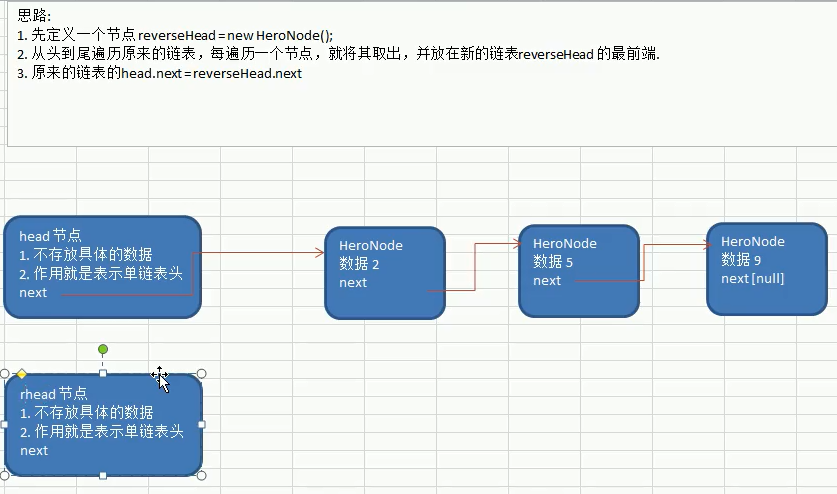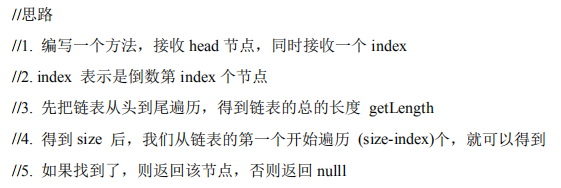链表-反转、逆序打印、查找倒数第K个节点
1、链表反转:

2、逆序打印单链表:
方式1:反向遍历
方式2:Stack栈

3、查找单链表倒数第K个节点

代码实现:
package exercise; import java.awt.*; import java.util.Stack; /** * @author : zhang * @version : 1.0 * @date : Create in 2021/7/25 * @description : */ public class reverse { public static void main(String[] args) { //先创建节点 HeroNode hero1 = new HeroNode(1, "宋江", "及时雨"); HeroNode hero2 = new HeroNode(2, "卢俊义", "玉麒麟"); HeroNode hero3 = new HeroNode(3, "吴用", "智多星"); HeroNode hero4 = new HeroNode(4, "林冲", "豹子头"); //创建链表 SingleLinkedList singleLinkedList = new SingleLinkedList(); //加入节点 singleLinkedList.add(hero1); singleLinkedList.add(hero2); singleLinkedList.add(hero3); singleLinkedList.add(hero4); //遍历链表 System.out.println("原链表为:"); singleLinkedList.list(); //反转链表 【腾讯面试题】 //System.out.println("反转后的链表为:"); //reversetList(singleLinkedList.getHead()); //singleLinkedList.list(); //逆序打印链表 【百度面试题】 System.out.println("逆序打印链表:"); reversePrint(singleLinkedList.getHead()); //获取链表有效节点的个数 int length = getLength(singleLinkedList.getHead()); System.out.println("链表有效节点的个数为:"+length); //查找单链表中的倒数第k个节点 【新浪面试题】 HeroNode lastIndexNode = findLastIndexNode(singleLinkedList.getHead(), 1); System.out.println("倒数第K个节点为:"+lastIndexNode); } //反转链表 【腾讯面试题】 public static void reversetList(HeroNode head) { //如果当前链表为空,或者只有一个节点,无需反转,直接返回 if (head.next == null || head.next.next == null) { return; } //定义一个辅助的指针(变量),帮助我们遍历原来的链表 HeroNode cur = head.next; HeroNode next = null; //// 指向当前节点[cur]的下一个节点 HeroNode reverseHead = new HeroNode(0, "", ""); //遍历原来的链表,每遍历一个节点,就将其取出,并放在新的链表reverseHead 的最前端 //动脑筋 while (cur != null) { next = cur.next;//先暂时保存当前节点的下一个节点,因为后面需要使用 cur.next = reverseHead.next; //将cur的下一个节点指向新的链表的最前端 reverseHead.next = cur; //将cur 连接到新的链表上 cur = next; //让cur后移 } //最后一步:将head.next 指向 reverseHead.next , 实现单链表的反转 head.next = reverseHead.next; } //逆序打印链表 【百度面试题】 //利用栈这个数据结构,将各个节点压入栈中,然后利用栈的先进后出的特点,就实现了逆序打印的效果 public static void reversePrint(HeroNode head) { if (head.next == null) { return; } //创建一个栈,将各个节点压入 Stack<HeroNode> stack = new Stack<>(); HeroNode cur = head.next; //将链表所有的节点压入栈 while (cur != null) { stack.push(cur); cur = cur.next; //cur后移,这样就可以压入下一个节点 } //将栈中的节点进行打印,pop 出栈 while (stack.size() > 0) { System.out.println(stack.pop());//stack的特点是先进后出 } } //获取单链表节点的个数 public static int getLength(HeroNode head) { if (head.next == null) { //空链表 return 0; } int length = 0; //定义一个辅助的变量, 这里我们没有统计头节点 HeroNode cur = head.next; while (cur != null) { length++; cur = cur.next;//遍历 } return length; } //查找单链表中的倒数第k个结点 【新浪面试题】 //1. 编写一个方法,接收head节点,同时接收一个index //2. index 表示是倒数第index个节点 //3. 先把链表从头到尾遍历,得到链表的总的长度 getLength //4. 得到size 后,我们从链表的第一个开始遍历 (size-index)个,就可以得到 //5. 如果找到了,则返回该节点,否则返回nulll public static HeroNode findLastIndexNode(HeroNode head, int index) { //判断如果链表为空,返回null if (head.next == null) { return null;//没有找到 } //第一此遍历得到链表的长度(节点个数) int size = getLength(head); //第二次遍历 size-index位置就是我们倒数的第K个节点 //先做一个index的校验 if (index <= 0 || index > size) { return null; } //定义辅助变量,for循环定位到倒数的index HeroNode cur = head.next; for (int i = 0; i < size - index; i++) { cur = cur.next; } return cur; } } //定义SIngleLinkedList 管理我们的英雄 class SingleLinkedList { //先初始化一个头结点,头结点不要动,不存放具体的数据 private HeroNode head = new HeroNode(0, "", ""); //返回头结点 public HeroNode getHead() { return head; } //添加节点到单向链表 //思路,当不考虑编号顺序时 //1. 找到当前链表的最后节点 //2. 将最后这个节点的next 指向 新的节点 public void add(HeroNode heroNode) { //因为头节点不能动,因此我们需要一个辅助遍历 temp HeroNode temp = head; //遍历链表,找到最后 while (true) { //找到链表的最后 if (temp.next == null) { break; } //如果没有找到最后,将temp后移 temp = temp.next; } //当退出while循环时,temp就指向了链表的最后 //将最后这个节点的next指向新的节点 temp.next = heroNode; } //第二种方式在添加英雄时,根据排名将英雄插入到指定位置 //(如果有这个排名,则添加失败,并给出提示) public void addByOrder(HeroNode heroNode) { //因为头节点不能动,因此我们仍然通过一个辅助指针(变量)来帮助找到添加的位置 //因为单链表,因为我们找的temp 是位于 添加位置的前一个节点,否则插入不了 HeroNode temp = head; boolean flag = false; //false标志添加的编号是否存在,默认为false while (true) { if (temp.next == null) { break; } if (temp.next.no > heroNode.no) {//位置找到,就在temp后面插入 break; } else if (temp.next.no == heroNode.no) { //说明希望添加的heroNode编号已经存在 flag = true; break; } temp = temp.next; //后移,遍历当前链表 } //判断flag的值 if (flag) { //不能添加,说明编号存在 System.out.printf("准备插入的英雄的编号 %d 已经存在了, 不能加入\n", heroNode.no); } else { //插入链表中(temp的后面) heroNode.next = temp.next; temp.next = heroNode; } } //修改节点的信息,根据no编号来修改 public void update(HeroNode newHeroNode) { if (head.next == null) { System.out.println("链表为空!"); return; } //找到需要修改的节点, 根据no编号 //定义一个辅助变量 HeroNode temp = head.next; boolean flag = false; //表示是否找到该节点 while (true) { if (temp == null) { break; } if (temp.no == newHeroNode.no) { flag = true; break; } temp = temp.next; } //根据flag 判断是否找到要修改的节点 if (flag) { temp.name = newHeroNode.name; temp.nickname = newHeroNode.nickname; } else { //没有找到 System.out.printf("没有找到 编号 %d 的节点,不能修改\n", newHeroNode.no); } } //删除节点 //思路 //1. head 不能动,因此我们需要一个temp辅助节点找到待删除节点的前一个节点 //2. 在比较时,是temp.next.no 和 需要删除的节点的no比较 public void del(int no) { HeroNode temp = head; boolean flag = false; //标志是否找到待删除的节点 while (true) { if (temp.next == null) { break; } if (temp.next.no == no) { flag = true; break; } temp = temp.next; } //判断flag if (flag) { //找到 //可以删除 temp.next = temp.next.next; } else { System.out.printf("要删除的 %d 节点不存在\n", no); } } //显示链表[遍历] public void list() { //判断链表是否为空 if (head.next == null) { System.out.println("链表为空"); return; } //因为头节点,不能动,因此我们需要一个辅助变量来遍历 HeroNode temp = head.next; while (true) { //判断是否到链表最后 if (temp == null) { break; } //输出节点的信息 System.out.println(temp); //将temp后移, 一定小心 temp = temp.next; } } } //定义HeroNode ,每个HeroNode 对象就是一节点 class HeroNode { public int no; public String name; public String nickname; public HeroNode next; //指向下一个节点 public HeroNode(int no, String name, String nickname) { this.no = no; this.name = name; this.nickname = nickname; } @Override public String toString() { return "HeroNode{" + "no=" + no + ", name='" + name + '\'' + ", nickname='" + nickname + '\'' + '}'; } }


